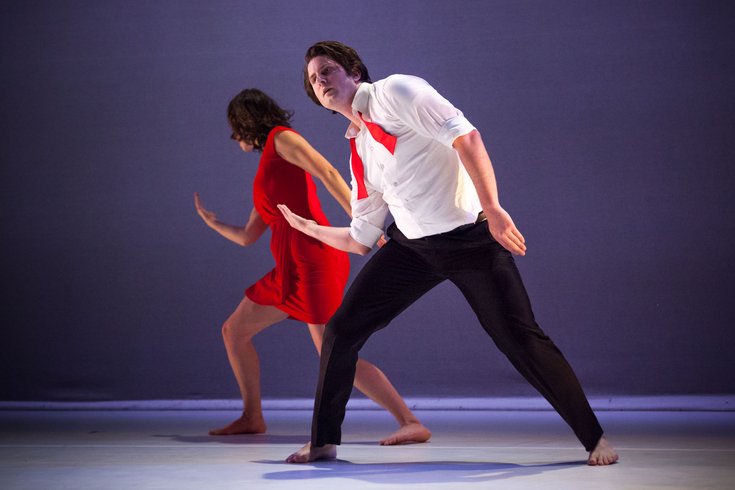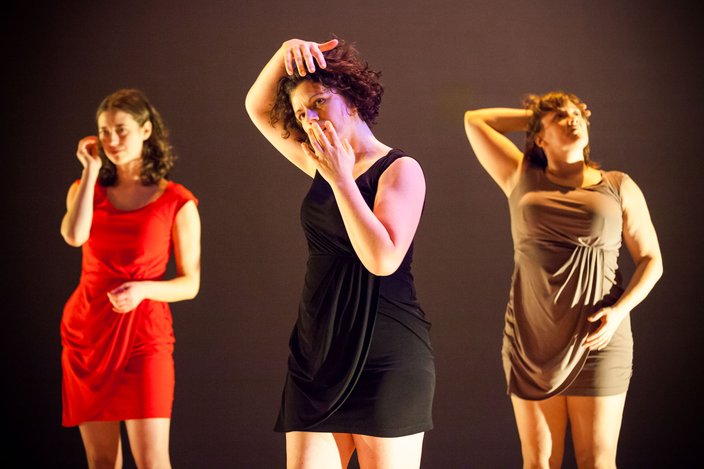
February 06, 2015
 Thom Carroll/for PhillyVoice
Thom Carroll/for PhillyVoice
'The Delicate Hour,' by Molly Shanahan and Mad Shak, is performed at Temple University's Mitten Hall on Friday, January 23. Temple students are one of many in the region who will be impacted by Dance/UP's loss of funding.
If there’s something the dance community surely needs more of – other than funding, of course – it is hope.
While there is some good news to report on the dance front – attendance was up by 4 percent from 2009-12, according to the 2014 Portfolio, and Philadelphia maintains one of the 10 largest ballet companies in the country (Pennsylvania Ballet) – it tends to come along with a heaping basket of bad news. For example, while ticket prices increased during that period of time, and, proportionally, dance companies earned more revenue from ticket sales than either music or theater, the prices didn’t quite keep up with inflation – meaning no one’s really making big money off ticket sales, unless you’re funding “The Nutcracker.” Subscription numbers are also way behind music and theater – there’s an 86,000-subscription gap between dance and theater in Philadelphia. And though there are as many dance organizations in the region as there are theater, the total budget they work with is less than half of theater's, and their attendance numbers about a third.
Yes – surprise, surprise, dance is an underfunded and, debatably, underappreciated art form, even in Philadelphia.
But what’s most research-relevant to Dance/UP’s somewhat unusual scenario is a paragraph buried in a 2014 report on the Philadelphia arts and culture nonprofit sector using Cultural Data Project numbers (“Capitalization, Scale, and Investment: Does Growth Equal Gain?”), commissioned by – who else? -- the William Penn Foundation:
“In summary, we found weakness to be the prevalent condition of financial health across the ecosystem, particularly for younger organizations, performing arts organizations, and those in growth mode. The ecosystem, therefore, remains poorly positioned to manage risk and implement change, and it continues to face the challenge of building adequate capitalization. What this means in practice is visionary leaders who are hampered from pursuing exciting directions because they do not have the working capital to secure a necessary contract. …”
It’s the predictable plight of an organization being lectured about not being sustainable enough, but not having the means to actually do anything about it. (See: the Performance Garage project.)
Other key findings of the study: Nonprofit arts organizations are chasing a shrinking pie of funders; nonprofit arts groups grew 64 percent from 1995 to 2008, meaning there’s more competition; large organizations are taking the biggest slices of the pie, with the very large organizations poised to take them now that the recession is over; foundations were the No. 1 provider of contributed funds for cultural nonprofits in Philadelphia by 2011; new attendees to performing arts shows aren’t coming back for repeat shows; and no one has a clue whether a new generation of individual donors will actually take an interest in funding the arts.
Nor is Dance/UP’s own struggle as a cultural nonprofit – a service nonprofit, at that – one that’s an anomaly.
Ruth Birnberg, former executive director of Boston Dance Alliance (so, that city's Dance/UP), told PhillyVoice.com that she made the decision to step down at the end of 2014 when she realized much more of her job was going to be devoted to diversifying fundraising than actual programming. She says she’s noticed foundations narrowing their focus areas since the recession hit (much as William Penn has seemingly shifted to education in recent years), but that they still shouldn’t discount arts service organizations like Dance/UP – if only to support the small companies they still claim to serve.
"By supporting dance service organizations, it's a way to be reaching and having that impact without having to look through 30 or 40 grants for a few thousand dollars each,” Birnberg says. “But those few thousand dollars make a huge difference, and by using us as an intermediary, we made a real impact.”
There’s also precedence for Philadelphia arts service organizations having to close up shop after struggles with funding. In the case of Theatre Alliance, which folded in 2012, it was up for grant renewal with the William Penn Foundation but decided against moving forward with the proposal at all.
“More and more, funders are looking for earned revenue sustainability,” Margie Salvante, former director of Theatre Alliance, told PhillyVoice.com. “Theatre Alliance, when I was leading it, we were working very hard to establish new programming so that we would get startup contributions for them, but in order to get those startup contributions, we needed to demonstrate an ability to turn it into earned revenue in a short period of time.”
"By supporting dance service organizations, it's a way to be reaching and having that impact without having to look through 30 or 40 grants for a few thousand dollars each,” says Ruth Birnberg, former director of Boston Dance Alliance. “But those few thousand dollars make a huge difference, and by using us as an intermediary, we made a real impact.”
The problem: “Our ability to earn revenue put us in direct competition with our members.”
So, the organization closed; only recently did Theatre Philadelphia emerge for the sole purpose of reviving the briefly defunct Barrymore Awards.
Ironically, the example most in line with Dance/UP’s current situation is the last dance service organization that existed in Philadelphia, Dance Alliance.
“What happened to us, is – and you’re going to laugh at this – but we relied very heavily on the William Penn Foundation. They were incredibly generous for a long time, until they weren’t,” Susan Glazer, who was director of Dance Alliance until 2003, told PhillyVoice.com. “And what happened, was during the early ‘00s -- it’s a family foundation and they have the right to determine their own set of priorities -- they deprioritized us. We didn’t fit into their strategic plans.”
Her simple explanation for why a dance service organization has trouble getting funding is that it lacks the “glamour” of dance companies; its efforts are in supporting companies to do what they don’t have the time or resources to do, making success difficult to quantify and … well, lacking the sex appeal of an edgy, tangible art project.
The result: An endless cycle of births and deaths for service organizations like Dance/UP.
“I was sad to see Dance/UP lose all of its funding,” Glazer adds. “But you know, that’s just the nature of the ballgame.”
Looking to the Future
To the point: What’s next?
“We’ll keep working with the community to see which programs are most valued. … In the end, the community will have to come together to create their new version of a dance service organization, because if it won’t step up, no outside org will come in to force one to be created,” Amy Fitterer, executive director of Dance/USA, told PhillyVoice.com. She’s supported the local branch by being physically present during the crisis but admits she doesn’t have the funding to actually help. “Hopefully, something will emerge. But they get created, they rise, they collapse, and it starts all over. They do have a volatile life cycle.”
Lois Welk, meanwhile, says she’s just fine with staying “in a state of ambiguity,” as far as her plans for staying in or leaving Philadelphia are concerned. She’s currently sorting through the feedback from the community meetings and a batch of e-surveys issued earlier in January to decide how to farm out the organization’s programs to dance companies in the city. (Helen Haynes, chief cultural officer of the city of Philadelphia's arts and culture office, told PhillyVoice.com she has great interest in at least taking the dance-floor rental program – though it’s about the only help the city can provide.)
But the overall air of uncertainty is leaving some impatient.
Jay Oatis, a New York transplant and graduate from Temple University’s Boyer School of Music and Dance, says the closure of Dance/UP – and possible exodus of Welk -- is just one more reason he’s eyeing auditions outside the region.
“I keep seeing all these f-----g articles about how Philadelphia is a great place to live, and it’s on the brink of amazing – you know, ‘BuzzFeed: 31 Reasons Why You Need to Move Here!’ And there’s such a vibrant arts community here, but if stuff like this continues to happen, people are going to leave, they’re going to lose hope,” he told PhillyVoice.com. “I hope enough people are interested in and find the funding for something similar [to Dance/UP].”
“And,” he adds, “they need to find their next Lois Welk, if she doesn’t stay. Because when you lose her, you lose a lot.”

A performance of "The Delicate Hour," by Molly Shanahan and Mad Shak, at Temple University's Mitten Hall on Friday, Jan. 23. / Thom Carroll, staff photographer for PhillyVoice.com
And that’s why this matters: If you lose the bloodstream of a community, what does it matter if an unbeating heart’s still there? It stifles the growth of a dance community that has been poised to gain momentum in recent years – especially with the cost of living in dance capitals like New York hitting the stratosphere, and FringeArts bringing dance to a mainstream audience. It’s like shoving gum in a flowing pipe; so, as much as Welk doesn’t want the conversation to be about saving her or Dance/UP, it kind of is.
“I think people may not come here so readily now,” Philadanco's Joan Myers Brown says. “People were moving out of New York because the expense was killing them – the opportunity to perform, the support systems here, they were coming here for that. But I’m not moving to Philly if I can’t get something out of it. Me, I’m just stuck here,” – she laughs – “It’s too late for me.”
But it’s not too late for people like Oatis, who have no ropes tying them here. If the resources aren’t here, they’ll find them somewhere else – in states like Alabama, even, where there might not be a city dance service organization, but there is a state one. (Another failed business model Welk tested, by the way.)
“I keep seeing all these f-----g articles about how Philadelphia is a great place to live, and it’s on the brink of amazing – you know, ‘BuzzFeed: 31 Reasons Why You Need to Move Here!’ And there’s such a vibrant arts community here, but if stuff like this continues to happen, people are going to leave, they’re going to lose hope,” Jay Oatis, a local dancer, told PhillyVoice.com. “I hope enough people are interested in and find the funding for something similar [to Dance/UP].”
“Dance/UP closing might not have a huge impact on existing companies [like mine], but it will impact emerging artists and new artists moving into the city,” Eun Jung Choi, a dancer who moved her company here from New York in 2009, told PhillyVoice.com. “It’s really important to have a central place. New York, for example, is a mecca for dance, so there’s always a place for people to present and connect. But Philly is a small community – everyone knows each other, but there are tiny pockets throughout the neighborhoods. And because of Dance/UP, all of those pockets came to a central place to have conversation.”
She adds, audibly frustrated: “Now that Dance/UP is removed, I don’t know if that will happen.”
Risky Business
In a cavernous, dimly lit “Conversation Hall” at City Hall, Welk calls on her fleet of dancers to go back to their seats after another round of sticker-dot stamping. As she does so, my eye catches two people in front of me interacting and ignoring her pleas.
“Oh my gosh! We really should have met before!” says one older, curly-gray-haired woman, approaching a familiar face.
The young woman she’s speaking to, dressed in black and reacting with a piercing screech of acknowledgment, responds in kind – lighting up with excitement. Their hands fold together in an act of kindness and unity. They gab about their work for a few brief moments, exchange information and then nestle back into their seats – satisfied -- as Welk continues to call for order over the microphone.
It’s not obvious – blink, and you’d miss it – but it’s the sort of connection folks like Jung Choi mean when they bemoan the loss of an organization that’s seemingly small and nonessential to someone writing a check. It’s a comfort in an industry hammered with reminders that it’s far from the top of the totem pole in the arts spectrum. Art, in general, comes with risk, but dance comes with a lot more of it.
“’Risky Business,’ that’s what I called my latest production,” Myers Brown explains one afternoon as we stroll through the Kimmel Center. “It’s a double entendre, you see, because the work we do – throwing dancers around, catching, jumping – all that sliding we do, it’s highly risky.”
And then she tilts her head and looks at me with seriousness, ushering in the apparent moment of insight.
“But also the fact that you never know where you’ll get that next dollar.”